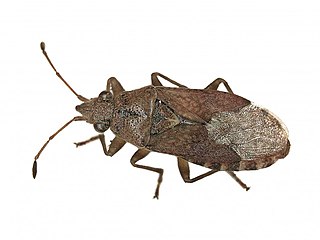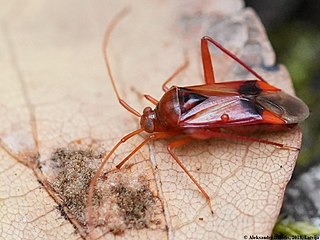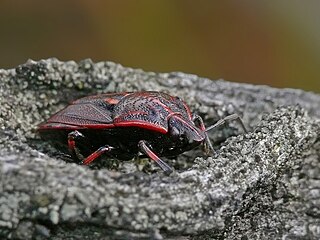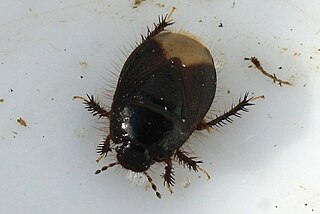
Pentatomidae is a family of insects belonging to the order Hemiptera, generally called shield bugs or stink bugs. Pentatomidae is the largest family in the superfamily Pentatomoidea, and contains around 900 genera and over 4700 species. As hemipterans, the pentatomids have piercing sucking mouthparts, and most are phytophagous, including several species which are severe pests on agricultural crops. However, some species, particularly in the subfamily Asopinae, are predatory and may be considered beneficial.

Miris is type genus of mirid bugs belonging to the family Miridae, subfamily Mirinae. The genus was first described in 1794 by Johan Christian Fabricius.

Orthotylinae is a subfamily of plant bugs in the family Miridae. There are at least 650 described species and at least 70 genera in Orthotylinae. The Orthotylinae have traditionally been diagnosed by their possession of lamellate, apically divergent parempodia.

Orsillus is a genus of Palaearctic bugs, in the family Lygaeidae; it is the type genus of the subfamily Orsillinae and tribe Orsillini. Species are recorded from Europe and includes O. depressus which has become naturalised in the British Isles.

Podops is a genus of Palaearctic bugs, in the family Pentatomidae; it is the type genus of the subfamily Podopinae and tribe Podopini. Species are recorded from Europe and includes the type species P. inunctus, which can be found in the British Isles.

Campylosteira is a genus of lace bugs in the tribe Tingini. Species are recorded from Asia, Africa, North America and Europe and includes C. verna found in the British Isles.
Oncochila is a genus of lace bugs in the tribe Tingini. Species are recorded from temperate Asia and Europe and includes O. simplex found in the British Isles.
Platycranus is a genus of mostly European capsid bugs in the tribe Orthotylini, erected by Franz Xaver Fieber in 1858. The species P. bicolor has been recorded from the British Isles.

Megacoelum is a genus of European, African, Asian and Australian capsid bugs in the tribe Mirini, erected by Franz Xaver Fieber in 1858. The species Megacoelum infusum is recorded from northern Europe including the British Isles.
Tinicephalus is a genus of mostly European capsid bugs in the tribe Phylini, erected by Franz Xaver Fieber in 1858. The species Tinicephalus hortulanus is recorded from northern Europe including the British Isles.

Gampsocoris is the type genus of the subfamily Gampsocorinae and tribe Gampsocorini. These stilt bugs species are mostly recorded from Europe and Africa.
Pseudomegacoelum is a genus of mostly European capsid bugs in the tribe Mirini, erected by Chérot and Malipatil in 2016. The type species, Pseudomegacoelum beckeri is recorded from northern Europe including the British Isles.
Hypseloecus is a genus of capsid bugs in the tribe Pilophorini, erected by Odo Reuter in 1891. Records are mostly from Europe, with some in Africa, Asia and Australia. The type species Hypseloecus visci is recorded from northern Europe including the British Isles.
Pachytomella is a genus of mostly European capsid bugs in the tribe Halticini, erected by Odo Reuter in 1891. The species Pachytomella parallela is recorded from northern Europe including the British Isles.
Psallodema is a genus of mostly European capsid bugs in the tribe Phylini, erected by V.G. Putshkov in 1970. The species Psallodema fieberi is recorded from northern Europe including the British Isles.

Hadrodemus is a genus of mostly European capsid bugs in the tribe Mirini, discovered by Franz Xaver Fieber in 1858. The type species Hadrodemus m-flavum is recorded from northern Europe including the British Isles.
Pachycoleus is a genus of bugs in the family Dipsocoridae, erected by Franz Xaver Fieber in 1860. The type species Pachycoleus waltli is recorded from northern Europe including the British Isles.

Xylocoridea is a monotypic genus of exclusively European flower bugs in the tribe Cardiastethini, erected by Odo Reuter in 1876. The "xylo-" prefix indicates that these insects are associated with wood.

Jalla is a genus of European shield bugs in the subfamily Asopinae erected by Carl Wilhelm Hahn in 1832. The type species Jalla dumosa is recorded from northern Europe including the British Isles.

Byrsinus is a genus of burrowing bugs in the tribe Geotomini, erected by Franz Xaver Fieber in 1860. The species Byrsinus flavicornis is recorded from northern Europe including the British Isles.











